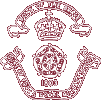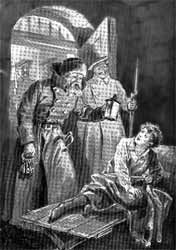


 |
 |
|
 |
||
| Navigation links at the bottom of this page | ||||||||||||||||||||||||||||||||||||||||||||||||||
1852 Crime and punishment |
||||||||||||||||||||||||||||||||||||||||||||||||||
In a report written for the Edinburgh Review, published in 1857, the Rev. George Gleig reported having seen boys of the RMA walking in the grounds of the Chelsea institution with 'logs chained to their wrists'. This, he reported, was a form of punishment. He also reported that for misdeamours and inattention during school work, children were hoisted in cages to the high ceiling of the main assembly hall, hauled into place on a rope and pulley arrangement. There is no documentary evidence whatsoever to support his 'chained log' observation and only one mention of a school punishment cage in very early documentation. A single mention of 'the cage' appears in a report written by the Adjutant to the Board of Commissioners (c 1809). Gleig was not a reliable witness. Had the use of logs chained to a boy's wrists been a form of punishment this would have to have been recorded in the punishment books (see National Archives document WO 143/53 Record of boys offences for 1852 to 1855). It is hardly likely that so barbaric a punishment would have been introduced in 1856 (the year Gleig reported seeing boys carrying logs for punishment). Unfortunately, and like so many of the Rev's unsubstantiated observations, later writers accepted his work as proven truth. In contrast, the commandant's punishment book for 1852 provides an insight into offences boys committed and the punishments meted out to them in a one year. This is not a complete listing of offences or punishments, but is typical of both and not chosen to by anything more than average offences and punishments. Even so, for the inconsistencies they represent they are worth discussing, first the listing: |
||||||||||||||||||||||||||||||||||||||||||||||||||
|
||||||||||||||||||||||||||||||||||||||||||||||||||
These punishments, even the mildest, are out of all proportion to the offences committed by any standards. A dozen and two dozen cuts (stripes or strokes – see glossary below) for relatively mild infractions such as 'unsuitable conduct' or 'not following an order of movement' seems well beyond reason. 'Talking in chapel' brought twice the number of strokes than those given for showing 'gross disrespect of Sgt. Fraser'. The only thing it shows is the gravity the commandant attached to religious instruction. The three consecutive punishments of 10 days drill with days spent in the black hole are, likewise, disproportionate to the offence. 'Beating a corporal', for example, was considered only slightly more onerous than 'swearing at a brother', the beating bringing the perpetrator an additional day in the black hole. Then there are those days of 'drill and work' for using insolent, not necessarily foul, language to an NCO, 'refusing to answer a question' and 'laughing in the ranks'; how less severe the punishment than for refusing to turn in the ranks or 'talking in chapel'. Again, an offence in connection with church gets the offender 10 days drill and three days in the black hole. What ghastly crimes and punishments one finds connected with church and religion. In contrast, for stealing 2/6 (two shillings and six pence, for readers unfamiliar with the old currency) from an honest workman gets a boy a mere nine strokes that, compared with the heavier sentencing, is mere kindergarten chastisement. The severity of punishments given diminished over the years. The black hole went out of use before the turn of the century and the number of strokes given were reduced to a maximum of six by the eve of the Second World War. Stripes, cuts or strokes, all meaning the same thing, were given by the regimental sergeant major, who delivered them on the culprit's backside in the manner described below (see Stripes). Days of drill also fade from the punishment books. The most extreme form of punishment, not recorded in the punishment books but still an event in living memory was a 'drumming out parade' conducted in regimental fashion for that grossest of crimes, sodomy, which could not be entered in the punishment books. Words entered in the punishment books for this behaviour were 'dismissed for gross indecency' and similar phrases. A drumming-out ceremony was part of the dismissal procedure, but again not registered in the book. Here is an explanation of some of the punishments used in 1852: Stripes, used interchangeably with ' cuts' or 'strokes' was the word used in the mid-1800s to describe the use of the 5 ft to 6 ft long bamboo cane. The bamboo cane had joints or knuckles at 18 inch to 20 inch intervals, which gave the instrument flexibility. Punishment was administered by the RSM with the help of the company sergeant (company sergeant majors or CSMs later replaced company sergeants)*. The sergeant placed the boy's head in his crotch and took a firm grip with his legs, pulled the boy's shirt tail out of his trousers, and gripped the top of his trousers to stretch and present a smooth surface for the rod. The boy was instructed to grip the sergeant's legs above the knee in a firm arm lock. It was all done with methodical and firm intent. The RSM administered the punishment with the strength and swing of golfing pro. (See 'A flippant solution' under 1904 Corporal punishment.) Punishment drill was carried out under the command of a boy NCO. Those on punishment drill assembled on the parade square, usually at the end of the school day, after supper and trades training. The punishment drill squad under the duty NCOs command would do parade drill, marching, counter-marching, forming fours, saluting, numbering off in a single rank with the tallest on the right and shortest boy on the left. The purpose of numbering was to form two ranks - odd numbers to the front, even numbers to the rear. Ordered to face in opposite directions, the files formed were then marched to form in column of route, the rear file following the front rank in line. As a result, the column formed with the tallest at the ends and shortest in the middle. Punishment drill with work was the same as the punishment drill described with the addition of work detail. Punishment work varied from duties such as cleaning pots and pans in the kitchen and scrubbing floors to dry scrubbing the parade square with a scrubbing brush. |
||||||||||||||||||||||||||||||||||||||||||||||||||
| The black hole was a place of the solitary confinement of boys, which could be for up to 4 days, often given in addition to stripes and punishment drill. Black hole is a military term to describe any dark cell in which soldiers (or in this case, boys) were confined for defined periods. It is speculated that actual 'black hole cells' varied from place to place. No description of a black hole cell has been found in military literature. Cells could be anything from a hole in the ground to a prison-like cell with a stout door of wood or iron railings. Whatever the place of confinement at the RMA Chelsea, it is certain on the evidence of the record that days of incarceration in the black hole were very common, suggesting that more than one 'cell' was available for this purpose. There is on record the case of Pte** Enos Seta who was awarded an additional 3 days in the black hole for throwing his mug of water at the sergeant-major and calling him a fathead. | "A word of advice, lad; your sergeant major is not a fat head." |  |
||||||||||||||||||||||||||||||||||||||||||||||||
* Note: Following the school's return to Dover following the Second World War, captains replaced company sergeant majors as heads of companies (or houses) and who were, in their turn, replaced by civilian housemasters for boys and housemistresses for girls. Back ** Boys of the RMA were
at one time designated Privates; hence the reference to Pte Enos Seta.
If this name strikes one as peculiar consider the name of Luciphina
Sinning, who entered the institution at age 6 years and 11 months,
7 October 1827. On 17 September 1834, at age 13 years, Luciphina was
delivered to Messrs H & J McConnel, London agents for
Cressbrook Mills, Derbyshire, to work on the cotton looms. |
||||||||||||||||||||||||||||||||||||||||||||||||||
| ||||||||||
|
© A. W. Cockerill 2011 Site Map Contact me | ||||||||||